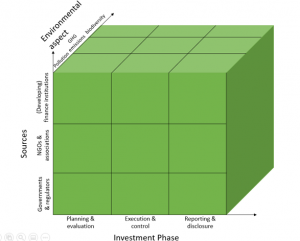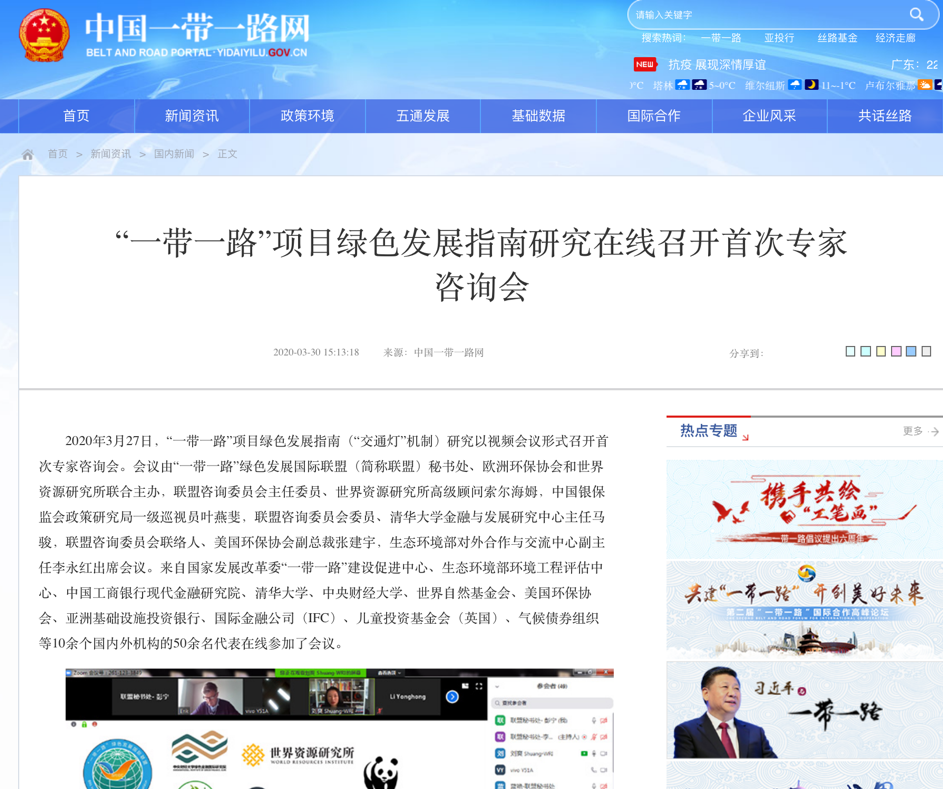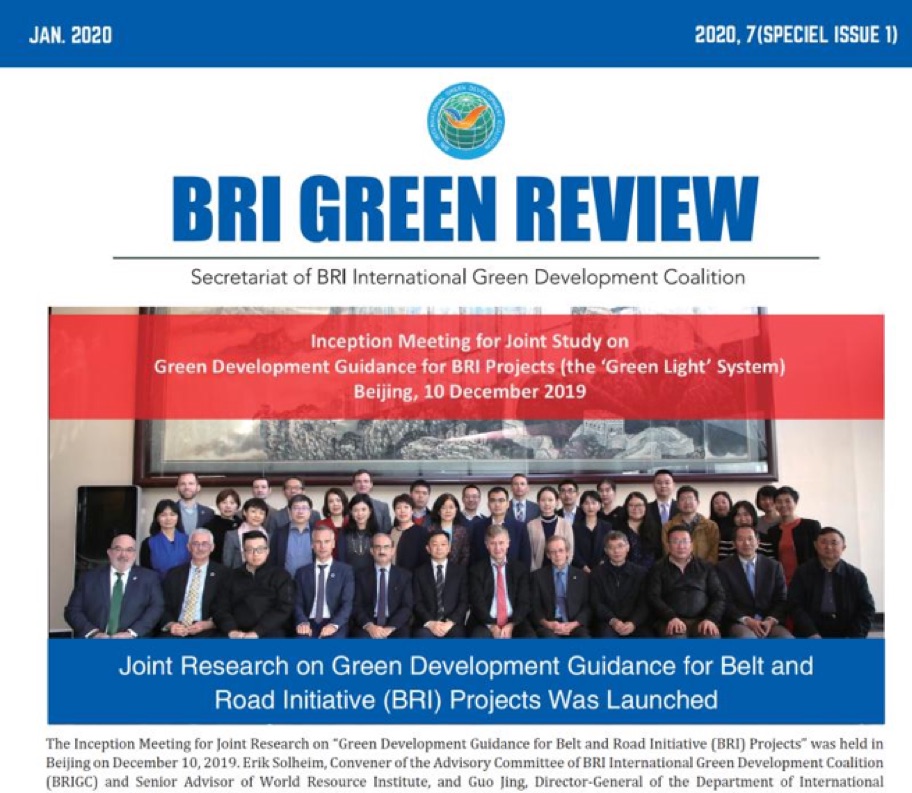On Friday, March 27, 2020, the Belt and Road Initiative Green Coalition (BRIGC) under the guidance of the Chinese Ministry of Ecology and Environment (MEE) organized an online-meeting to discuss the first version of the “Green Light System” (Chinese: 交通灯) for the Belt and Road Initiative (BRI). The following article describes the background of this potentially groundbreaking framework.
Background of the Belt and Road Initiative Green Coalition (BRIGC)
The Belt and Road Initiative International Green Development Coalition (BRIGC) (you can find more information on the BRIGC here) was established after the second Belt and Road Forum in April 2019. The BRIGC is supervised by the Chinese Ministry of Ecology and Environment (MEE) with its own secretariat.
The main goal of the BRIGC is
“to promote international consensus, understanding, cooperation and concerted actions to realize green development on the Belt and Road, to integrate sustainable development into the BRI through joint efforts and to facilitate BRI participating countries to realize SDGs related to environment and development.”
The BRIGC is open to participation to government departments, local and international organizations, think tanks, private sector stakeholders, civil society organizations.
By April 2020, over 130 Chinese and international organizations have joined the initiative. The work of the BRIGC is divided into 10 thematic partnerships:
- Biodiversity and ecosystem management
- Green energy and energy efficiency
- Green finance and investments
- Improvement of environmental quality and green cities
- South-south environmental cooperation and SDG capacity building
- Green technology, innovation and corporate social responsibility
- Sustainable transportation
- Climate change governance and green transformation
- Environmental legislation and standards
- Maritime community with a shared future and marine environment governance
The thematic partnerships are led by both Chinese and international partners. Each working group develops their own work plan and shares progress with the overall BRIGC.
Green Light System for the Belt and Road Initiative Background
Pursuing green development within the Belt and Road Initiative (BRI) has been part of the design of the BRI since it was announced in 2013 by Chinese President Xi Jinping. At the 2019 Belt and Road Forum, President Xi stressed the relevance and importance of building a green BRI. Accordingly, the BRIGC announced in October 2019 to deliver a study on how a green light system to evaluate BRI investments in regard to their environmental performance could look like. The system was supported by then MEE Minister LI Ganjie. On December 10, 2019, the inception meeting with representatives from over 20 Chinese and international organizations took place in Beijing. The participants strongly supported the idea of building an evaluation tool for BRI investments.
Guo Jing, Director-General, Department of International Cooperation of MEE said:
“To pursue the high-quality development of Belt and Road cooperation, we need to implement the principle of green development. We need to focus on addressing three issues. First, how to assess and minimize the potential eco-environmental implication of BRI projects and align with the 2030 Sustainable Development Goals (SDGs) so as to provide a model for participating countries to follow in realizing green development. Second, how to identify the priority of project investment from the perspective of ecological and environmental risk prevention. Third, whether it is possible to identify specific project areas through developing this green development guidance.”
Eric Solheim, Convener of the BRIGC Advisory Committee and Senior Advisor of WRI said:
“The aim of launching the joint research on the “Green Light” System is to promote green development. This is a clearly set objective. The Belt and Road Initiative, which has become the largest investment framework of our time, is an opportunity that should be seized. The outputs of this joint research could provide an eco-environmental risk prevention system for BRI projects. I would like to propose five recommendations concerning the implementation of the joint research. First, the “Green Light” System should play a positive role in guiding green development and promote the greening of BRI projects while maintaining economic growth. Second, global best practices and standards should be the source of reference. Third, the joint research should be rooted in China with the participation of Chinese stakeholders. Fourth, the deliverables should be simple and easy-to-use, so as to guarantee high eficiency in use. Fifth, the “Green Light” System should cover major environmental issues, including climate change, environmental pollution, nature protection, and biodiversity conservation.“
Accordingly, a consortium consisting of WRI, Client Earth, WWF, Appraisal Center for Environment and Engineering (ACEE) of the MEE and IIGF was set up to conduct in-depth research on international and Chinese best practices on greening overseas direct investments (ODA).
Green Light System Baseline Study
The scope of the baseline study was to identify the most practical mechanisms that mitigate environmental and climate impacts of China’s overseas investments while accelerating development opportunities offered through BRI investment in regard to improvements to human lives, economies, and environments in host countries. The Green Light builds on previous studies, such as the first version of a project categorization regarding environmental impacts suggested in the special policy report on the Green Belt and Road Initiative in 2019.

The baseline study draws from China’s and international best practices, in regard to
- different sources of best practices, such as
- government and regulators,
- non-government organizations (such as financial associations, NGOs), and
- financial institutions that support investment decision-making from the perspective of prevention and mitigation of eco-environmental risks, particularly regarding overseas investments.
- Best practices in regard to different environmental aspects of BRI investments to support “green finance”
- Pollution, particularly air pollution
- Greenhouse gas emissions (GHG) to protect against climate change
- Biodiversity protection
- In regard to different phases of the investment lifecycle
- Project planning and evaluation
- Project execution and control
- Reporting and disclosure
Figure 2 gives an overview of the sources of three-dimensional best-practice analysis framework.

The baseline study particularly aims to build a policy framework that accelerates government support for a green BRI, while incorporating financial institution’s requirements. The baseline study is also a foundation for investors to minimize their financial exposure to environmental risks in the BRI and “prevent best firms being undermined by unscrupulous competitors”.
The Green Light Study is complementary to the BRI Green Investment Principles (GIP) that were 27 global financial institutions (e.g. Agricultural Bank of China, Bank of China, CDB, EXIM Bank, Deutsche Bank, Silk Road Fund) in April 2019 to accelerate greening of the BRI with its 7 principles:
- Embedding sustainability into corporate governance
- Understanding environmental, social and governance risks
- Disclosing environmental information
- Enhancing communication with stakeholders
- Utilizing green financial instruments
- Adopting green supply chain management
- Building capacity through collective action
The introduction of the first draft of the baseline study for the Green Light System on March 27, 2020 was attended by a global consortium via video conference. Experts were asked to give detailed feedback on the goals, measures and implementation of the proposals, which were incorporated for the next meeting of the BRIGC on April 1, 2020 with over 100 participants.

The study is still ongoing and is moving into the next phase for further consultation. We will keep updating the results of the “Greenlight System for the BRI” here.
Dr. Christoph NEDOPIL WANG is the Founding Director of the Green Finance & Development Center and a Visiting Professor at the Fanhai International School of Finance (FISF) at Fudan University in Shanghai, China. He is also the Director of the Griffith Asia Institute and a Professor at Griffith University.
Christoph is a member of the Belt and Road Initiative Green Coalition (BRIGC) of the Chinese Ministry of Ecology and Environment. He has contributed to policies and provided research/consulting amongst others for the China Council for International Cooperation on Environment and Development (CCICED), the Ministry of Commerce, various private and multilateral finance institutions (e.g. ADB, IFC, as well as multilateral institutions (e.g. UNDP, UNESCAP) and international governments.
Christoph holds a master of engineering from the Technical University Berlin, a master of public administration from Harvard Kennedy School, as well as a PhD in Economics. He has extensive experience in finance, sustainability, innovation, and infrastructure, having worked for the International Finance Corporation (IFC) for almost 10 years and being a Director for the Sino-German Sustainable Transport Project with the German Cooperation Agency GIZ in Beijing.
He has authored books, articles and reports, including UNDP's SDG Finance Taxonomy, IFC's “Navigating through Crises” and “Corporate Governance - Handbook for Board Directors”, and multiple academic papers on capital flows, sustainability and international development.






Comments are closed.